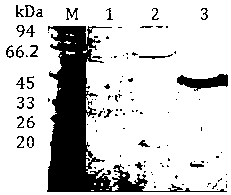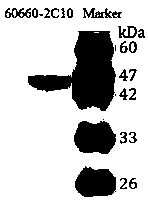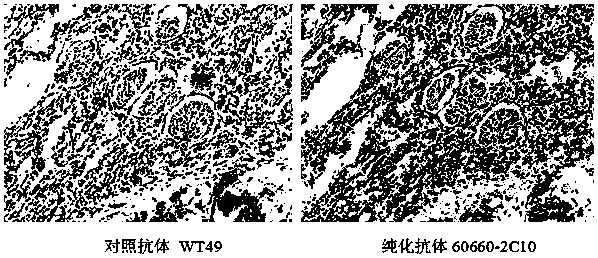A monoclonal antibody secreting anti-wt1 protein and its application
A monoclonal antibody, antigen technology, applied in the direction of anti-animal/human immunoglobulin, anti-receptor/cell surface antigen/cell surface determinant immunoglobulin, analytical materials, etc., can solve the problem of reduced sensitivity and other problems , to achieve high specificity and sensitivity
- Summary
- Abstract
- Description
- Claims
- Application Information
AI Technical Summary
Problems solved by technology
Method used
Image
Examples
Embodiment 1
[0031] Example 1 Preparation of recombinant WT1 protein fragments
[0032] i. WT1 recombinant protein synthesized a 577bp WT1 gene fragment (Nanjing GenScript Biotechnology Co., Ltd. company), added at the 5' and 3' ends of the gene, respectively Eco RI and xho I restriction sites and protective bases facilitate endonuclease digestion. The pET30a-GST vector was purchased from Merck, and the vector was also used Eco RI and xho I was digested, recovered by electrophoresis, and connected with T4 DNA ligase. The ligation product was transformed into Escherichia coli competent cells BL21 codonplus (Novogen, Merck), the clones on the plate were picked and inoculated, the plasmid DNA was extracted and identified by PCR. PCR showed that the fusion protein gene positive clones were sequenced and analyzed, and the clones with completely correct sequences were adopted.
[0033] Protein Expression and Purification
[0034] gene cloning for recombinant protein expression
[003...
Embodiment 2
[0078] Example 2 Establishment of hybridoma cell lines
[0079] 1. Immunity
[0080] About 500 μg (0.5 mg / ml) of the soluble recombinant protein obtained in Example 1 was emulsified with complete Freund's adjuvant (Sigma Company), and immunized with 4-6 week-old female Balb / c mice (purchased from Beijing Weitong Lihua Experimental Animal Technology Co., Ltd.), and each mouse was injected subcutaneously at 6 points in the abdomen, with a dose of 60 µg / only. Immunization was boosted once every 14 days, and the recombinant protein was emulsified with Freund's incomplete adjuvant (Sigma Company) at a dose of 30 μg per mouse. 7 days after the third booster immunization, indirect ELISA (wavelength 450nm) was used to detect the multi-antibody titer of the anti-immunogen in the mouse serum. 50µg / only.
[0081] 2. Cell Fusion
[0082] Aseptically prepare the mouse splenocyte suspension that reaches the immune standard, mix it with mouse myeloma cell sp2 / 0 (ATCC) at a ratio of 5:1, ...
Embodiment 3
[0087] Example 3 Preparation of monoclonal antibody by ascites induction method
[0088] 1. Ascites preparation
[0089] Cells in the logarithmic growth phase were washed with serum-free medium and suspended, counted to 5×10 5 , 1ml. The suspended cells were injected intraperitoneally into mice previously sensitized with paraffin oil. Ascites collection was started 7 days later. The removed ascites was centrifuged at 4°C at 4000 rpm for 10 min. Carefully suck out the ascites in the middle and collect in a centrifuge tube, and store at 4°C or -20°C.
[0090] 2. Purification of monoclonal antibodies
[0091] Antibody was purified from ascitic fluid by HiTrap rProtein A FF (GE Company) affinity chromatography according to the instructions. The purity was identified by SDS-PAGE gel, and the concentration was determined by Bradford method. Purified antibodies were stored at -20°C.
PUM
| Property | Measurement | Unit |
|---|---|---|
| melting point | aaaaa | aaaaa |
Abstract
Description
Claims
Application Information
 Login to View More
Login to View More - R&D
- Intellectual Property
- Life Sciences
- Materials
- Tech Scout
- Unparalleled Data Quality
- Higher Quality Content
- 60% Fewer Hallucinations
Browse by: Latest US Patents, China's latest patents, Technical Efficacy Thesaurus, Application Domain, Technology Topic, Popular Technical Reports.
© 2025 PatSnap. All rights reserved.Legal|Privacy policy|Modern Slavery Act Transparency Statement|Sitemap|About US| Contact US: help@patsnap.com



